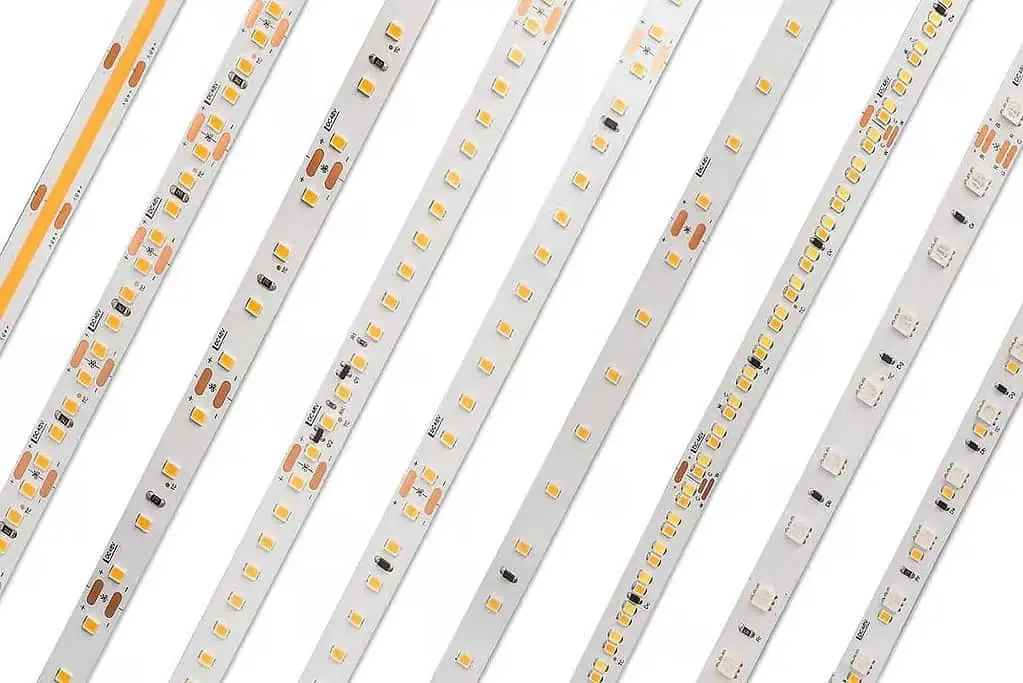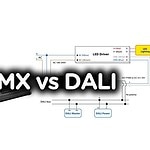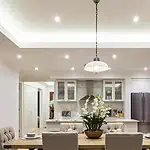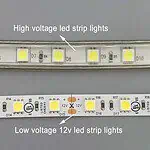Have you ever wondered why some LED strip lights have a dot or spot-like effect? This occurs due to low LED density as LEDs are mounted far apart along the strip length.
LED strips are available in different density options that greatly impact its light output. In this article, I will discuss all about LED strip densities and help you choose the right LED density that fits your needs best. Let’s begin:
What is LED Density On an LED Strip?
LED density refers to the number of LED chips installed per unit in LED strip lights. This is measured either in meters or in feet. For example, the LED density of 30 LEDs/m means there are 30 LEDs in each meter of LED strips.
The LED density has a greater impact on the lighting output of strip lights. High LED density means more LEDs per meter, giving brighter illumination. In contrast, low LED density brings up fewer LEDs in each meter and gives off less prominent illumination.
However, both high-density and low-density LED strips have particular use cases. For example- high-density fixtures are ideal for task lighting, whereas low-density ones work best in accent lighting. And for general lighting purposes, you should go with medium-density LED strips.

Common LED Density For LED Strip Lights
LED strips are available at varying densities. The most common ones are as follows:
| LED Density | Level Of Density | Application |
| 30 LEDs per meter | Low-Density | – Ambient lighting applications that need cozy ambiance, such as bedrooms and living rooms – Accent lighting of photo frames, staircase, etc. |
| 60 LEDs per meter | Medium Density | – Under cabinet lighting – Lighting up retail displays or shelves – Backlit TV or mirror |
| 120 LEDs per meter | High-Density | – Taskliging for desk and study area – Kitchen cabinet and island lighting – Closet or wardrobe lighting |
| 180 LEDs per meter | Ultra-High Density | – Architectural lighting – Photography and videography lighting – Laboratory lighting – Signage lighting |
| 240 LEDs per meter |
Besides these above-mentioned LED densities, other options are also available. Again, some LED strip manufacturers also offer customization facilities for LED density.

LED Density Vs. LED Count: Differences
LED count refers to the total number of LEDs installed within an LED strip of any length. Usually, LED strips come in 5 meters/reel. Therefore, the total LED present in these five meters is counted as LED count. It allows you to have an idea of power consumption and light brightness.
In contrast, LED density considers the number of LEDs per meter. It determines how uniform and smooth the lighting output is.
So, if a 5-meter LED strip reel has an LED density of 30LED/m, its LED count is (30 x 5) = 150 LEDs. Similarly, if the length of the LED strip is 2 meters, its LED count is (30 x 2) = 60 LEDs.
High LED Density Vs. Low/Standard LED Density: How Does LED Density Affect the Light Output Of LED Strips?
Brightness
LEDs are the lighting component in LED strip lights. So, more LEDs per meter means higher brightness. Therefore, LEDs with high-density give brighter illumination than low-density ones.
Note: The comparison must be with LEDs of the same type, with an equal lumen rating, current draw, and SMD. This is because, in some cases, you will get the same lighting input from a low-density strip with high-power LEDs and a high-density strip with low-power LEDs.
Uniform Lighting & Hotspots
The LED density greatly impacts the uniformity and smoothness of light output. When you switch on high density LED strips, the space between the LED chips is small and doesn’t show any visible gap. This way, you are polished and even lighting.
| High LED density = Less space between the LEDs = More uniform lighting |
| Low LED density = More space between the LEDs = Less uniform (may show gaps) |
In contrast, low-density lights have LEDs placed far apart. As a result, gaps are often visible, which results in a hotspot effect.
Power Draw
With the increase in LED numbers, the power draw also increases. So, high-density LED strips have higher power consumption than low-density strips.
| LED Density ⇑ Power Consumption ⇑ |
| LED Density ⇓ Power Consumption ⇓ |
For instance, a 120 LEDs/m strip light usually consumes 12W to 24W per meter or more. At the same time, a 30 LEDs/m strip consumes only 2W to 6W per meter.
Note: The comparing LED strips must have the same LEDs and power rating.
Heat Generation & Thermal Resistance
Due to having higher power consumption, high-density COB LED strips generate more heat. To protect them from overheating, they have built-in thermal resistance systems like heat sinks. Besides, these LED strips have a thicker PCB to resist overheating.
On the other hand, low-density LED strips have fewer LED chips and draw less power. These fixtures don’t get overheated easily. So, having built-in heat sinks or thermal management systems is not important for low LED density.
Lifespan
As LED strips with higher density consume more power, they are prone to overheating. If the heat dispersion is not sufficient, this can impact the lifespan of the LEDs. In contrast, low-density LED strips are less prone to overheating. But here, each LED chip goes through a higher drive current to enhance the overall light output. This tends to overheat individual chips, shortening their lifespan.
Why Use High-Density LED Strips? – Benefits
- Brighter illumination
- Uniform and smooth lighting
- Better thermal management
- Ideal for professional lighting requirements
Drawback Of Using Low-Density LED Strip
- Creates hotspot
- Less bright than high-density LED strip
- May overdrive LED chips and shorten their lifespan
- Not ideal for large and professional installation
How Does LED Density Affect LED Strip Pricing?
LED chips are the main component of LED strip lights. And with the increase in LED numbers, the price also increases. This is why high-density LED strips are more expensive than low-density ones.
Usually, one LED costs about 5 cents. Over it, the additional costs for materials like PCB, wiring, etc., are added. This cost less than $1.00 USD per meter. Considering all this, the cost of a low-density and high-density LED strip comes as follows:
| LED Density | Price Of LEDs | LED Strip Assembly Cost | Total Costing |
| 30LEDs/m | 30 LEDs x 5 cents = $1.50 | $1.00/per meter | $1.50 (LEDs) + $1.00 (strip) = $2.50 |
| 120LEDs/m | 120 LEDs x 5 cents = $6.00 | $1.00/ per meter | $6.00 (LEDs) + $1.00 (strip) = $7.00 |
Therefore, you must consider LED density while setting the budget for your LED strips. If you are on a very tight budget, go for low-density LED strips. However, for uniform and better light output, spending more on high-density LED strips is worth investing.
Note: The price of LED strips also depends on the brand, quality, features, and power of LED chips.

How Can You Identify High-Density LED Strips from Others?
Here, I’m sharing some tips to quickly identify high-density LED strips from other LED densities:
Read Packaging Label
LED strip packaging has labeling indicating the LED density. If it’s an LED strip of 30 or 60 LEDs/m, consider it a standard or low-density LED strip. And take it as high-density for a density of 120LEDs/m or above.
Compare Spacing Between LEDs
If you can’t find labeling or any packaging, simply place LED strips of different densities side by side to compare the LED spacing. The strip that has less spacing between LEDs is a high-density LED strip. Again, the strips that have a large gap between LED chips are low-density LED strips.
Turn on The Light & Observe The Light Output
You can power on the light and observe its lighting output to detect whether it is high LED density or low-density LED strips. High-density LED strips give off uniform light, leaving no hotspot. On the other hand, low-density LED strips will have visible hotspots when lit. This way, you can quickly identify them.
How To Determine The Right LED Density For LED Strip?
Application & Brightness Needs
As the lighting output of LED strips differs for LED density, considering application and brightness requirements is essential. For general residential areas, a medium density of 60LEDs/m is a good option. Again, for tasks and professional lighting that require bright illumination, go for high LED density lights. However, if you are planning for accent lighting, standard or low-density LED strips work best.
Lighting Effect
If you want a polished, smooth, and uniform lighting effect, choose high-density LED strips, 120LEDs/m or more. However, if smooth lighting output is not crucial and you are ok with the hotspot effect, purchase low LED density like 30LEDs/m or 60LEDs/m.
Budget
If budget is not an issue, go for high-density LED strips for better light output. Though this is expensive, you will get a professional and bright illumination. But for a low-budget project, choosing a low-density LED strip is ok. These are affordable and easily available at local stores.
FAQs
For highly dense LED arrangements, the spacing between LEDs is minimal. As a result, the lighting is evenly distributed throughout the length, and you get a smooth and uniform illumination. Meanwhile, in low-density LEDs, the LEDs are placed far apart. As a result, the illumination is not evenly disturbed all over the LED strip, which creates hot spots.
30 to 60 LED/m are considered as standard LED density. You can also call them low-density LED strip lights.
High-density LED strips consume more power, which will raise your electricity bills. Besides, they are more prone to overheating and are more expensive than low-density LED strips.
Low-density LED strips are cheaper than high-density LED strips. They consume less energy. However, the illumination of these lights is not as bright and uniform as high-density LED strips.
The Bottom Line
To get your desired lighting effect, you must consider LED density while purchasing LED strip lights. However, note down your application and lighting requirements to choose the right LED density.
Nevertheless, LEDYi LED strips come with varying LED densities. Moreover, we also offer customization faculty to provide you with the right LED density that meets your installation requirements. So why wait anymore? Contact us right now!












